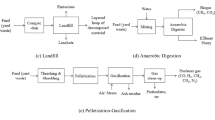Abstract
A novel approach to quantify and apply the municipal solid waste management hierarchy is presented in this study. In this study, weights were assigned to the treatment methods using the analytical hierarchy process. The consistency ratio was found to be within the allowable range (0.10), indicating that weights assigned met the requirements of the analytical hierarchy process. The assigned weights for the municipal solid waste hierarchy treatment methods were prevention = 0.44, reduction/minimization = 0.27, reuse = 0.12, recycle = 0.08, incineration = 0.05, and landfilling = 0.04. The highest benefits were derived when all the treatment methods in the municipal solid waste hierarchy were applied based on the optimum weights generated by the analytical hierarchy process. It was, however, observed that a combination of reduction/minimization, reuse and recycling, was more effective and beneficial. Also, selecting only one treatment method gave the least benefits except for reduction/minimization. Also, applying up to two treatment methods yielded much benefit in some instances compared to a combination of three. When the proposed model was applied to data obtained from the Accra Metropolitan Assembly in Ghana on population and total municipal solid waste received at selected landfill sites over a period of 7 years, it proved to be ultimately effective. The developed municipal solid waste hierarchy model equations, when properly applied will ensure sustainable treatment and provide for the exploitation of municipal solid waste resources. It is therefore a new promising module for effective planning, decision making, and sustainable municipal solid waste management.


Similar content being viewed by others
References
Ahmed S, Vedagiri P, Krishna Rao KV (2017) Prioritization of pavement maintenance sections using objective based analytic hierarchy process. Int J Pavement Res Technol 10(2):158–170. https://doi.org/10.1016/j.ijprt.2017.01.001
Akil AM, Foziah J, Ho CS (2015) The Effects of socio-economic influences on households recycling behaviour in Iskandar Malaysia. Procedia Soc Behav Sci 202:124–134
Chang CY et al (2009) Characteristics of elements in waste ashes from a solid waste incinerator in Taiwan. J Hazard Mater 165(1–3):766–773
Geng J et al (2015) The stability of bound chlorides in cement paste with sulfate attack. Cem Concr Res 68:211–222. https://doi.org/10.1016/j.cemconres.2014.11.010
Gentil EC, Gallo D, Christensen TH (2011) Environmental evaluation of municipal waste prevention. Waste Manag 31(12):2371–2379. https://doi.org/10.1016/j.wasman.2011.07.030
Jibril JDA, Sipan IB, Sapri M, Shika SA, Isa M, Abdullah S (2012) 3R s critical success factor in solid waste management system for higher educational institutions. Procedia Soc Behav Sci 65:626–631
Lam CHK et al (2010) Use of incineration MSW ash: a review. Sustainability 2(7):1943–1968
Muniafu M, Otiato E (2010) Solid waste management in Nairobi, Kenya. A case for emerging economies. J Lang Technol Entrep Afr 2(1):342–350
Noori R, Karbassi A, Salman Sabahi M (2010) Evaluation of PCA and Gamma test techniques on ANN operation for weekly solid waste prediction. J Environ Manag 91(3):767–771. https://doi.org/10.1016/j.jenvman.2009.10.007
Oteng-Ababio M (2011) Missing links in solid waste management in the Greater Accra Metropolitan Area in Ghana. GeoJournal 76(5):551–560
Ouda OKM, Raza SA, Al-Waked R, Al-Asad JF, Nizami A-S (2015) Waste-to-energy potential in the Western Province of Saudi Arabia. J King Saud Univ Eng Sci 29:212–220
Palanivel TM, Sulaiman H (2014) Generation and composition of municipal solid waste (MSW) in Muscat, Sultanate of Oman. APCBEE Procedia 10:96–102
Pathania A, Rasool G (2017) Investigating E tailer’s perceived website quality using analytical hierarchy process technique. Procedia Comput Sci 122:1016–1023
Pokhrel D, Viraraghavan T (2005) Municipal solid waste management in Nepal: practices and challenges. Waste Manag 25(5):555–562
Saaty RW (1987) The analytic hierarchy process—what it is and how it is used. Math Model 9(3–5):161–176
Salhofer S et al (2008) Potentials for the prevention of municipal solid waste. Waste Manag 28(2):245–259
Scarlat N et al (2015) Evaluation of energy potential of municipal solid waste from African urban areas. Renew Sustain Energy Rev 50:1269–1286. https://doi.org/10.1016/j.rser.2015.05.067
Seniunaite J, Vasarevicius S (2017) Leaching of copper, lead and zinc from municipal solid waste incineration bottom ash. Energy Procedia 113:442–449
Simelane T, Mohee R (2012) Future directions of municipal solid waste management in Africa. Afr Inst S Afr 81:1–6
Strojny J (2015) Implementation of the AHP and benchmarking in strategic analysis of Polish regions. Procedia Soc Behav Sci 213:229–235. https://doi.org/10.1016/j.sbspro.2015.11.530
Sun X, Li J, Zhao X, Zhu B, Zhang G (2016) A review on the management of municipal solid waste fly ash in american. Procedia Environ Sci 31:535–540
Tettey I, Pimpong S (2016) Examining waste-to-resources potential from municipal solid waste: evidence from Pantang Dumpsite in ACCRA. Ghana IV(12):533–548
Trang PTT et al (2017) The effects of socio-economic factors on household solid waste generation and composition: a case study in Thu Dau Mot, Vietnam. Energy Procedia 107:253–258. https://doi.org/10.1016/j.egypro.2016.12.144
Vaidya OS, Kumar S (2006) Analytic hierarchy process: an overview of applications. Eur J Oper Res 169(1):1–29
Van Ewijk S, Stegemann JA (2016) Limitations of the waste hierarchy for achieving absolute reductions in material throughput. J Clean Prod 132:122–128. https://doi.org/10.1016/j.jclepro.2014.11.051
Vijaya MN (2010) Application of an analytical hierarchy process to prioritize the factors affecting ERP implementation. Int J Comput Appl 2(2):1–6
Vijaya MN et al (2010) Application of an analytical hierarchy process to prioritize the factors affecting ERP implementation. Int J Comput Appl 2(2):1–6
Zorpas AA, Lasaridi K (2013) Measuring waste prevention. Waste Manag 33(5):1047–1056. https://doi.org/10.1016/j.wasman.2012.12.017
Acknowledgements
Our heartfelt thanks go to Mr. Victor Neequaye Kotei of the Accra Metropolitan Assembly, for providing relevant data for this study.
Author information
Authors and Affiliations
Corresponding author
Additional information
Editorial responsibility: J Aravind.
Rights and permissions
About this article
Cite this article
Yakubu, Y., Zhou, J. Novel approach to quantify municipal solid waste management hierarchy based on analytical hierarchy process. Int. J. Environ. Sci. Technol. 16, 1897–1908 (2019). https://doi.org/10.1007/s13762-018-1768-x
Received:
Revised:
Accepted:
Published:
Issue Date:
DOI: https://doi.org/10.1007/s13762-018-1768-x




